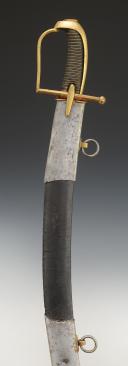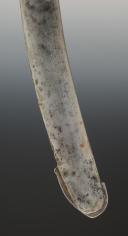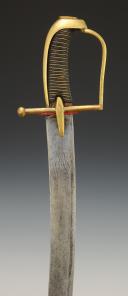
Hussar Troopers Sabre, An IV model, Revolution (approximately from 1792 to 1802). Stock number 30369.
Sold out
HUSSAR TROOP SABER, Year IV model, Revolution (approximately from 1792 to 1802). 30369
Brass hilt, single-branch guard stamped with a "B" under the Phrygian cap of the 1st class controller F. Bisch (1792-1798), long-tailed pommel, handle of black waxed calf leather wrapped around wood filigreed with brass. Curved blade with hollow flutes, length 80.6 cm, width at the ricasso 3.7 cm, engraved on the back "KLINGENTHAL"; on one side of the blade, on its first third is engraved "Rpe" and on the other side "Franse"; it is stamped with a "B" surmounted by the Phrygian cap of the 1st class controller F. Bisch (1792-1798) and the oval stamp "MK" in a beaded crown corresponding to the Klingenthal manufacture stamp (1792-1798). Red wool knot. Wooden scabbard covered with black waxed leather with two large steel fittings with brass belt loops and steel rings. Steel blade tip. Brass cupped chape.
France.
Revolution period.
Good condition.
NOTE:
Michel Pétard writes in his work "The History of Hussar Sabers from Louis XIV to the Present Day," Canonnier Editions 2010, "The republican version of the 1777 saber is distinguished from its direct ancestor by its iron-trimmed scabbard. No significant archive allows us to know its genesis, but the comparison of markings on numerous specimens demonstrates productions ranging from around 1792 to 1798 mainly from Klingenthal. At the same time, productions from requisitioned private industry were also very present, sometimes using blades forged at Klingenthal. Of course, the large fleur-de-lis engraved on the blade under the monarchy up to 1792 gives way to the monogram "Repe" "Franse" engraved on either side of the blade. The back still bears the word "KLINGENTHAL" engraved in bold capitals. Saber figure 33: Klingenthal stamps between 1793 and 1798. Saber figure 34: Klingenthal stamps between 1798 and 1802."
Brass hilt, single-branch guard stamped with a "B" under the Phrygian cap of the 1st class controller F. Bisch (1792-1798), long-tailed pommel, handle of black waxed calf leather wrapped around wood filigreed with brass. Curved blade with hollow flutes, length 80.6 cm, width at the ricasso 3.7 cm, engraved on the back "KLINGENTHAL"; on one side of the blade, on its first third is engraved "Rpe" and on the other side "Franse"; it is stamped with a "B" surmounted by the Phrygian cap of the 1st class controller F. Bisch (1792-1798) and the oval stamp "MK" in a beaded crown corresponding to the Klingenthal manufacture stamp (1792-1798). Red wool knot. Wooden scabbard covered with black waxed leather with two large steel fittings with brass belt loops and steel rings. Steel blade tip. Brass cupped chape.
France.
Revolution period.
Good condition.
NOTE:
Michel Pétard writes in his work "The History of Hussar Sabers from Louis XIV to the Present Day," Canonnier Editions 2010, "The republican version of the 1777 saber is distinguished from its direct ancestor by its iron-trimmed scabbard. No significant archive allows us to know its genesis, but the comparison of markings on numerous specimens demonstrates productions ranging from around 1792 to 1798 mainly from Klingenthal. At the same time, productions from requisitioned private industry were also very present, sometimes using blades forged at Klingenthal. Of course, the large fleur-de-lis engraved on the blade under the monarchy up to 1792 gives way to the monogram "Repe" "Franse" engraved on either side of the blade. The back still bears the word "KLINGENTHAL" engraved in bold capitals. Saber figure 33: Klingenthal stamps between 1793 and 1798. Saber figure 34: Klingenthal stamps between 1798 and 1802."
Reference :
30369

Next update Friday, april 4th at 1:30 PM
FOR ALL PURCHASES, PAYMENT IN MULTIPLE CHECKS POSSIBLE
bertrand.malvaux@wanadoo.fr 06 07 75 74 63
An authenticity certificate of the item including the description published on the site, the period, the sale price, accompanied by one or more color photographs is automatically provided for any item priced over 130 euros. Below this price, each certificate is charged 5 euros.
Only items sold by me are subject to an authenticity certificate, I do not provide any expert reports for items sold by third parties (colleagues or collectors).












